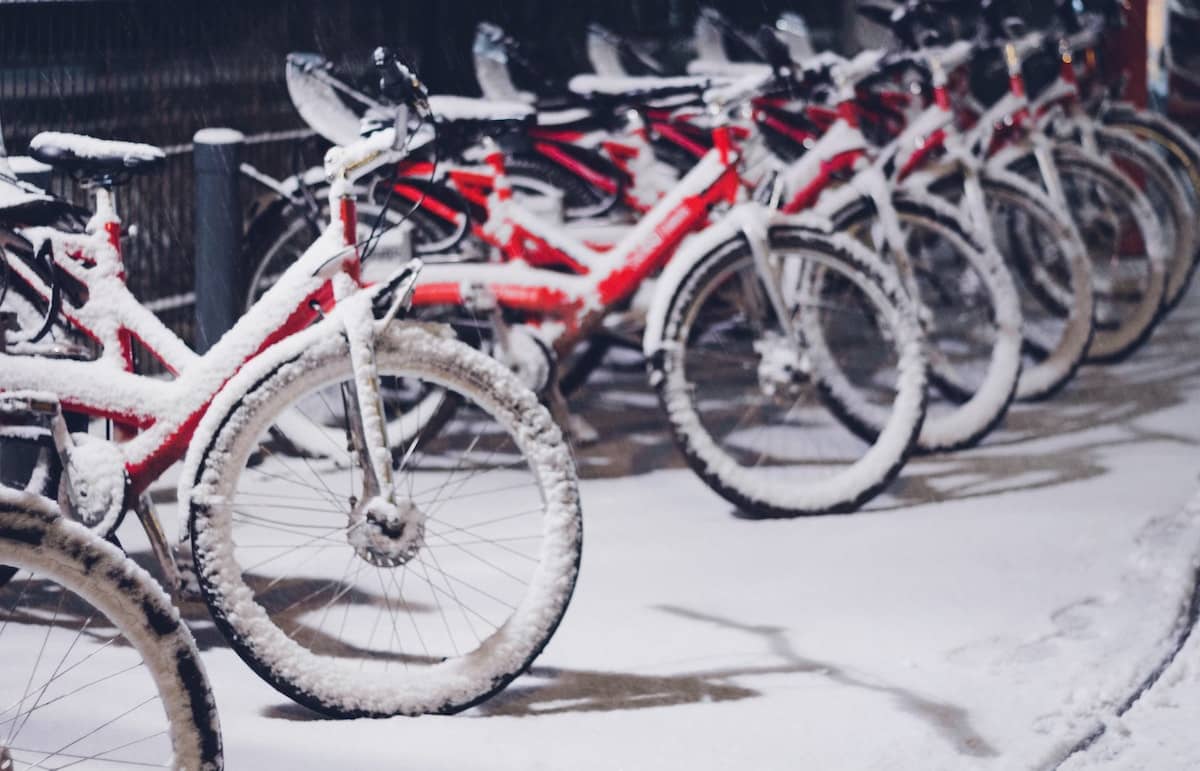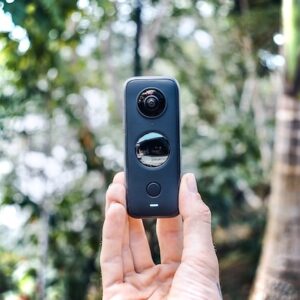Being on the road, cycling at a relaxed and smooth 30 km/h is one of the most freeing feelings there is in our sport. It feels like flying. It’s what we live for.
That is…unless it’s winter.
When the temperature drops and the winds pick up, being on the saddle for hours at a time can be a little less of an enjoyable experience. To make it through this time of the year, it’s good to have a specific plan in place. Here are some tips to get your prepared for cycling in winter.

Jump to:
Clothing
Wearing the proper clothing will be the primary dictator if you enjoy yourself or freeze your little cyclist tush off during the colder months.
Wear layered clothing on top of a proper base layer. A decent base will wick away sweat to keep you warm while adding the first layer of warmth. Wearing multiple layers allows you to warm-up, and then shed some layers if needed.
Even a nice pair of compression pants and shirt, such as from 2XU or Under Armour are a great idea.
A proper set of gloves can make a world of difference. If your hands are left open to the elements, no amount of clothing will keep you warm. A pair from Castelli or something from the Pearl Izumi Amfib series will work great.
On the other end (literally) are your feet. Make sure to invest in some warmer socks or even shoe covers when the temperature calls for it. Personally, I have a few pairs of merino wool socks for when I have to ride in the cold.
Tires
Having the correct tires for slippery roads is essential to keeping your bike up and you off the ground. If you live in an area where winter brings in a lot of moisture, make sure you have a pair of specific winter tires with “grippy” traction. (If you’re not sure if you’re tires are adequate for winter riding, you should be able to easily see a different between your regular “smooth” road tires, and grippy/textured winter tires.)
Do not go out on a trip in the cold with worn-down tires. This is a recipe for disaster.

Mud Guards
Another piece of equipment which can greatly improve the “enjoyability” of winter cycling are a pair of mud guards. Being that winter is generally wetter in many areas, riding without them will ensure you arrive at your destination with a nice line of mud and dirt on your back. And, riding in the cold with wet clothes is definitely not a great idea. Put this altogether with the fact you will ruin your new winter clothes, it’s best to avoid this.
While they may not be “cool”, it is a very easy, and cheap way to be better equipped for winter cycling. You’ll be cleaner, drier, and able to have more fun
A Winter Bike
If you have the funds and the needs call for it, having a dedicated winter bike may be your best option. The first option is to recycle an older bike and refit it with winter cycling in mind. This included the above mentioned wider and “grippier” winter tires and mud guards. Many people will also prefer a heavier bike to help with more traction and stability.
Another option is to buy one. Gravel bikes are becoming the preferred winter bike as these things are made to ride in the worst conditions even on the most beautiful day. They are beefier than road bikes which allows for more options, such as tire width, and attachments.
Some top picks come from Tommaso, Wiggle, and Salsa
You can still spend some time looking at these bikes to get some ideas to build your own bike as well
Proper Cleaning and Maintenance
Due to the increased moisture, your bike is going to pick up a lot more debris and mud than usual. Therefore, make sure to wash your bike down after every ride. This doesn’t mean you need to perform a deep clean every time, it just means that you just need to give it a good rinse and pay attention to the gears.
You’ll also want to make sure to use a good lube as well. Keep in mind the difference between wet and dry lube. Wet lube is thicker and harder to come off yet picks up more dirt. Dry lube is going to be more waxy and comes off easier, yet is is generally “cleaner”.
As dry lube will be washed off in wet conditions, most will prefer a thick, wet lube to use in Winter such as Finish Line or Muc-Off.

Insulated Thermos
Drinking ice-cold water when you’re feeling ice cold is not the best sensation. If you reside in a very cold region, invest in an insulated thermos. Something as simple as having some warm liquids can do wonders in keeping you warm. Plus, it may even encourage you to stay hydrated.
If you have never bought an insulated water bottle, check out the ones from Polar Bear.
Stay Hydrated
This is a great follow-up to having an insulated thermos. When we ride in the cold, we can mistakingly believe that we are staying hydrated as we don’t sweat as much. This is only partially true as we still lose liquids through respiration and urination. You will also still likely sweat as your body gets warmed up.
Unfortunately, we just don’t feel thirsty and tend to drink less, which causes dehydration. To ensure this doesn’t happen, remember to maintain a hydration protocol by drinking every 15 minutes.
Safer Routes
A consideration many overlook when cycling in winter is opting for safer routes. That is, you want to consider the impact of the winter weather on the route you’ll be riding through. If a route is poorly maintained, or has a tendency to be particularly icy, it’s a good idea to find a safer alternative.
Indoor Trainers
Depending on where you live, or how much you hate riding in the cold, indoor trainers can be a very good option.
Maybe your only choice.
(If you’re a child of the desert like I am, and you prefer fair-weather cycling year-round, indoors trainers will become essential to your overall happiness.)
Indoor trainers have evolved immensely over this past decade, along with interactive software such as Zwift and The Sufferfest. You can now set up a system in your living room that simulates riding the streets of Paris or futuristic virtual streets.
With a smart trainer, you can feel the added power needed to climb hills and experience the relief after reaching the summit and coasting downhill.
Plus, you can still have virtual meet-ups and races. There are even virtual leagues where points are kept for the season. If you enjoy live group rides, Zwift and Peloton are great ways to stay motivated during the cold.
Sure we like being on the open road, but indoor trainers can be a great tool and actually a lot of fun.
Staying Active
Regardless of whether you opt to brave the outdoors or stay inside on an indoor trainer, the most important thing is to stay active during this time of the year. There are numerous options available, just make sure you choose one and stick with it. And if you haven’t already, make sure to check out my guide to strength training for cycling.
And that’s it. Winter cycling can be daunting (especially if you’re a beginner cyclist!), but with the right preparation, and some good judgement, you can keep riding. But if you happen to live in a place where the winters are particularly harsh…*cough* Canada *cough*…Hang in there. Just a few more months until the sun will come out again!
Get our FREE NEWSLETTER! Follow on Instagram, and Pinterest for updates.







Steve Moore says
You make no mention of "danger of black ice" which has caused me to fall, in the past, before I overcome the desire to ride whatever the weather. The falls are different, you normally go down when you are low speed manoeuvring, and you go down fast and you go down hard. It's not always obvious that you are going to find black ice, you may start off riding in hard frost, which is not a problem (for me) but when you come to a well used road then beware.
badcyclist says
Great points, Steve! I mentioned the dangers of losing traction and black ice is a perfect example of where that might happen. Thanks for chiming in.